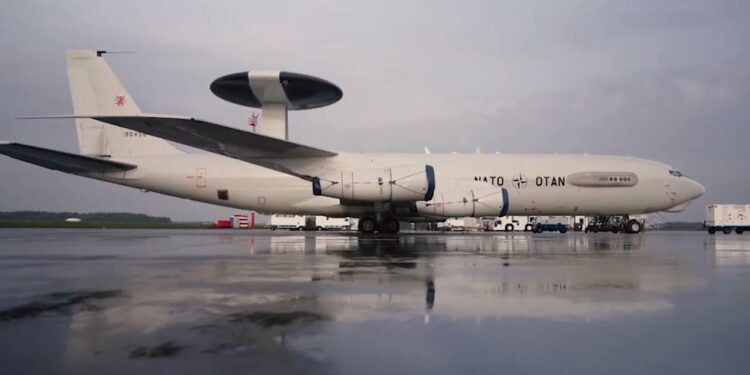NATO’s Airborne Warning and Control System (AWACS) aircraft have touched down in Lithuania as part of ongoing efforts to bolster surveillance and security in the Baltic region. This deployment underscores the alliance’s commitment to enhanced Vigilance Activities amid heightened geopolitical tensions. Stationed at ҆iauliai Air Base, the AWACS fleet will provide critical airborne radar coverage, improving situational awareness and threat detection across the strategically vital airspace shared by NATO allies and partners.
NATO AWACS Deployment Strengthens Baltic Air Surveillance Capabilities
Enhanced Air Surveillance capabilities in the Baltic region have received a significant boost with the recent arrival of NATO’s Airborne Warning and Control System (AWACS) aircraft in Lithuania. These specialized aircraft are equipped with advanced radar and communication systems that enable comprehensive monitoring of airspace, ensuring rapid response to any potential threats. Positioned strategically, the AWACS will work closely with Baltic and allied air forces to provide 24/7 situational awareness and intelligence sharing, a cornerstone for maintaining regional security amid evolving geopolitical challenges.
The deployment is a pivotal step supporting NATO’s Vigilance Activities, strengthening coordinated defense measures and reinforcing the alliance’s commitment to collective security. Key aspects of the AWACS contribution include:
- Real-time airspace tracking of both civilian and military aircraft.
- Enhanced command and control capabilities for allied aircraft.
- Interoperability between Baltic countries and NATO forces.
| Capability | Benefit |
|---|---|
| Multi-domain surveillance | Comprehensive air and maritime monitoring |
| Secure communication links | Faster data exchange with NATO command centers |
| Early warning systems | Improved threat detection and response times |
Enhanced Vigilance Activities Aim to Deter Regional Security Threats
NATO’s deployment of AWACS aircraft in Lithuania marks a significant step in bolstering aerial surveillance across the Baltic region. These sophisticated airborne warning and control systems provide critical real-time intelligence, ensuring early detection of any irregular air activity. This enhanced presence not only reassures allied nations but also acts as a strong deterrent against potential aggressors seeking to challenge regional stability. The increased situational awareness allows NATO forces to respond swiftly, maintaining a robust and credible defense posture amid evolving security dynamics.
Key features of the vigilance activities include:
- Extended radar coverage encompassing airspace over Lithuania, Latvia, Estonia, and surrounding areas.
- Improved coordination between allied airborne and ground surveillance units for seamless threat identification.
- Rapid information sharing with NATO command centers to accelerate decision-making processes.
- Increased joint training exercises to enhance operational readiness among Baltic states and member forces.
| Capability | Function | Benefit |
|---|---|---|
| AWACS Radar | 360¬į Air Surveillance | Early Threat Detection |
| Secure Data Link | Real-Time Communication | Faster Response Times |
| Command Integration | Multi-Unit Coordination | Unified Defense Strategy |
Recommendations for Sustaining Collaborative Intelligence and Rapid Response Efforts
To ensure the continued success of collaborative intelligence and rapid response operations in the Baltic region, it is imperative to foster strong interoperability among NATO allies. This involves standardizing communication protocols and investing in joint training exercises that simulate real-time scenarios. Regular data sharing and real-time intelligence exchange must remain a priority, enabling forces to anticipate threats swiftly and coordinate actions with precision. Emphasizing technological upgrades, such as enhanced surveillance systems and AI-driven analysis tools, will further enhance situational awareness across multinational teams.
Moreover, sustaining agility in decision-making processes calls for decentralized command structures that empower field units while maintaining strategic oversight. Support from local governments and civilian agencies through public-private partnerships can provide critical logistical and technological assistance. Below is a brief overview of key measures recommended for strengthening these efforts:
- Enhanced Training Programs: Cross-border simulations and workshops to boost readiness.
- Unified Communication Systems: Implementation of secure, interoperable communication networks.
- Technology Integration: Incorporation of AI and real-time analytics for faster threat assessment.
- Decentralized Command: Empowering local decision-makers with robust situational data.
- Public-Private Partnerships: Leveraging civilian sector capabilities for logistical support.
| Priority Area | Action Item | Expected Benefit |
|---|---|---|
| Training & Exercises | Joint multinational drills | Improved coordination and readiness |
| Communication | Standardized secure channels | Faster and reliable information flow |
| Technology | AI-enabled threat detection | Enhanced early warning capabilities |
| Command Structure | Decentralized decision-making | Increased operational flexibility |
| Partnerships | Collaboration with civilian agencies | Augmented logistical support |
To Conclude
The arrival of NATO AWACS aircraft in Lithuania marks a significant step in the alliance’s ongoing efforts to bolster surveillance and air policing capabilities across the Baltic region. As tensions persist in the wider European security landscape, enhanced vigilance activities underscore NATO’s commitment to collective defense and deterrence. With these advanced airborne early warning systems now operational in Lithuania, the alliance is better positioned to monitor and respond swiftly to any potential aerial threats, reinforcing stability and security for its member states in the region.
















